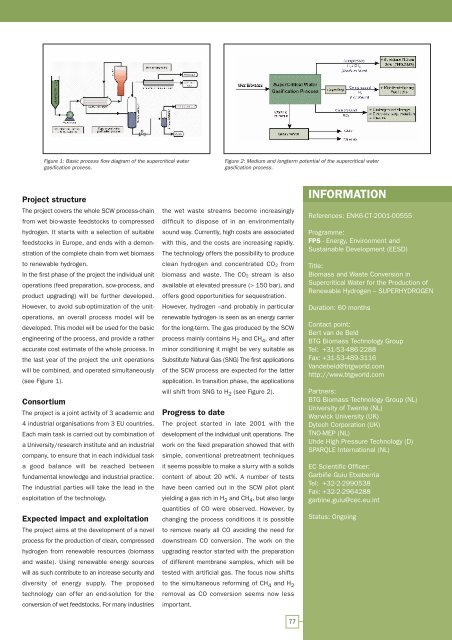European Bio-Energy Projects
European Bio-Energy Projects
European Bio-Energy Projects
Create successful ePaper yourself
Turn your PDF publications into a flip-book with our unique Google optimized e-Paper software.
Figure 1: Basic process flow diagram of the supercritical water<br />
gasification process.<br />
Project structure<br />
The project covers the whole SCW process-chain<br />
from wet bio-waste feedstocks to compressed<br />
hydrogen. It starts with a selection of suitable<br />
feedstocks in Europe, and ends with a demonstration<br />
of the complete chain from wet biomass<br />
to renewable hydrogen.<br />
In the first phase of the project the individual unit<br />
operations (feed preparation, scw-process, and<br />
product upgrading) will be further developed.<br />
However, to avoid sub-optimization of the unitoperations,<br />
an overall process model will be<br />
developed. This model will be used for the basic<br />
engineering of the process, and provide a rather<br />
accurate cost estimate of the whole process. In<br />
the last year of the project the unit operations<br />
will be combined, and operated simultaneously<br />
(see Figure 1).<br />
Consortium<br />
The project is a joint activity of 3 academic and<br />
4 industrial organisations from 3 EU countries.<br />
Each main task is carried out by combination of<br />
a University/research institute and an industrial<br />
company, to ensure that in each individual task<br />
a good balance will be reached between<br />
fundamental knowledge and industrial practice.<br />
The industrial parties will take the lead in the<br />
exploitation of the technology.<br />
Expected impact and exploitation<br />
The project aims at the development of a novel<br />
process for the production of clean, compressed<br />
hydrogen from renewable resources (biomass<br />
and waste). Using renewable energy sources<br />
will as such contribute to an increase security and<br />
diversity of energy supply. The proposed<br />
technology can offer an end-solution for the<br />
conversion of wet feedstocks. For many industries<br />
the wet waste streams become increasingly<br />
difficult to dispose of in an environmentally<br />
sound way. Currently, high costs are associated<br />
with this, and the costs are increasing rapidly.<br />
The technology offers the possibility to produce<br />
clean hydrogen and concentrated CO2 from<br />
biomass and waste. The CO2 stream is also<br />
available at elevated pressure (> 150 bar), and<br />
offers good opportunities for sequestration.<br />
However, hydrogen –and probably in particular<br />
renewable hydrogen- is seen as an energy carrier<br />
for the long-term. The gas produced by the SCW<br />
process mainly contains H2 and CH4 , and after<br />
minor conditioning it might be very suitable as<br />
Substitute Natural Gas (SNG) The first applications<br />
of the SCW process are expected for the latter<br />
application. In transition phase, the applications<br />
will shift from SNG to H2 (see Figure 2).<br />
Progress to date<br />
Figure 2: Medium and longterm potential of the supercritical water<br />
gasification process.<br />
The project started in late 2001 with the<br />
development of the individual unit operations. The<br />
work on the feed preparation showed that with<br />
simple, conventional pretreatment techniques<br />
it seems possible to make a slurry with a solids<br />
content of about 20 wt%. A number of tests<br />
have been carried out in the SCW pilot plant<br />
yielding a gas rich in H2 and CH4 , but also large<br />
quantities of CO were observed. However, by<br />
changing the process conditions it is possible<br />
to remove nearly all CO avoiding the need for<br />
downstream CO conversion. The work on the<br />
upgrading reactor started with the preparation<br />
of different membrane samples, which will be<br />
tested with artificial gas. The focus now shifts<br />
to the simultaneous reforming of CH4 and H2 removal as CO conversion seems now less<br />
important.<br />
77<br />
INFORMATION<br />
References: ENK6-CT-2001-00555<br />
Programme:<br />
FP5 - <strong>Energy</strong>, Environment and<br />
Sustainable Development (EESD)<br />
Title:<br />
<strong>Bio</strong>mass and Waste Conversion in<br />
Supercritical Water for the Production of<br />
Renewable Hydrogen – SUPERHYDROGEN<br />
Duration: 60 months<br />
Contact point:<br />
Bert van de Beld<br />
BTG <strong>Bio</strong>mass Technology Group<br />
Tel: +31-53-486-2288<br />
Fax: +31-53-489-3116<br />
Vandebeld@btgworld.com<br />
http://www.btgworld.com<br />
Partners:<br />
BTG <strong>Bio</strong>mass Technology Group (NL)<br />
University of Twente (NL)<br />
Warwick University (UK)<br />
Dytech Corporation (UK)<br />
TNO-MEP (NL)<br />
Uhde High Pressure Technology (D)<br />
SPARQLE International (NL)<br />
EC Scientific Officer:<br />
Garbiñe Guiu Etxeberria<br />
Tel: +32-2-2990538<br />
Fax: +32-2-2964288<br />
garbine.guiu@cec.eu.int<br />
Status: Ongoing

















